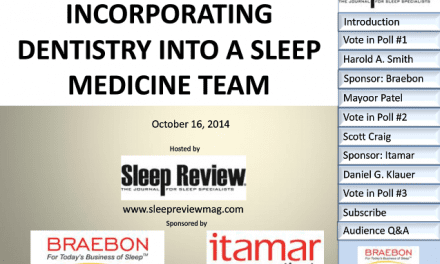Applications for the credential are up, and the certification’s administrators are working to makethe examination more accessible.

Lisa Hodgin, RPSGT, CRT, at Iuka Hospital in Dennis, Miss, earned her RPSGT in 2004. Hodgin was a respiratory technician, but felt that “every day was the same, seldom exciting.” When a position opened up in sleep, she decided to give it a try. “I fell in love with it,” she says. “I enjoy getting to know my patients—to help someone sleep better, feel better, and become a healthier person. Getting my RPSGT was one of the best things I have ever done.”
For Wes Moulden, RPSGT, Sleepwell Laboratory, Houston, the credential “is not about a better job or a raise.” Moulden says, “there is a certain degree of respect that having the RPSGT after your name grants you from fellow sleep professionals.”
Indeed, many who become certified take it upon themselves to encourage others to follow in their path by setting up incentives, programs, and mentoring sessions to help colleagues become registered. Paula Williams, MA, CRT, RPSGT, at the Diagnostic Center for Sleep Disorders, Chattanooga, Tenn, believes that “anyone currently in the field of sleep medicine should be actively pursuing his or her registry.” In fact, Williams says it is the center’s policy to begin preparing all new technologists to become credentialed from day one.
A New Era for the RPSGT
Exam March marked a major milestone for the RPSGT credential. Beginning that month, the exam became computer-based, a technological improvement that makes registering for—and taking—the examination easier.
In the past, the certification examination was administered only twice each year at a limited number of test sites. With the move to computer-based testing and a new partnership with Pearson VUE, a leading electronic testing service company, the RPSGT examination will now be offered 48 days of the year at hundreds of sites in the United States, its territories, and internationally.
In addition, applicants for the examination may now select the day and time within 2-week testing periods scheduled at four different times of the year.
“By adding more testing dates, we have made it easier to take the examination without running into conflicts with work schedules, family time, or religious observances, explains Bobby Stanley, executive director of the Board of Registered Polysomnographic Technologists (BRPT), the organization that administers the RPSGT credential. Adding more test sites has reduced the need for travel and lodging expenses for many of our applicants.”
An added benefit of computer-based testing is increased examination security and a faster turnaround for the results. Getting results quickly is particularly important for candidates since career opportunities and salary increases often come along with adding the credential.
First Steps to Applying
The BRPT offers support for potential candidates on its Web site at www.brpt.org. Start by downloading the free RPSGT Candidate Handbook, which includes everything from eligibility criteria to suggested reference materials and application procedures, as well as a detailed examination content outline that lets potential candidates see exactly how the 4-hour examination breaks down question by question. As the credentialing body, the BRPT cannot conduct review courses for the examination, but it does offer a study guide and two free online practice examinations. The Association of Polysomnographic Technologists (APT) offers information about review courses on its Web site at www.apt-web.org. Recognizing that more pathways to education for sleep technologists in preparation for the RPSGT examination are needed, a coalition of sleep organizations is currently exploring ways to make courses even more available.
The most common advice given by those who have earned the credential: Allow at least 6 months of study time prior to taking the examination and study, study, study!
The RPSGT exWhat is on the Examination?
Examination comprises 200 carefully selected questions. The examination itself is designed to be a professional evaluation that sets and measures minimum standards for polysomnographic technologists so that when a polysomnogram is conducted by an RPSGT, patients, doctors, and sleep facility administrators can be assured that the technologist has a level of competency that can be relied upon. Questions are based on a job analysis study conducted every 5 years to assure the examination reflects real-world practices. The study participants include a random sample of practicing polysomnographic technologists (both registered and nonregistered) who are asked to identify the important tasks sleep technologists perform each day in terms of patient care, the knowledge base critical to performing the work of a sleep technologist, and the tasks that need to be frequently performed in the course of a typical week by a sleep technologist. The examination is then structured to reflect theoretical and practical knowledge needed by sleep technologists.
A Community of Sleep Professionals
There are currently nearly 9,000 RPSGTs in the world. Considering the surge in demand in the sleep medicine field and the number of medical specialties that use polysomnography as a diagnostic tool, the number of practicing sleep technologists falls far short of demand. Due to the change to computer-based testing and the ease with which sleep technologists in other countries will now be able to find international test sites, the BRPT expects this number to grow exponentially over the next few years.
There is great demand for credentialed polysomnographic technologists,” explains Stanley. “The job of the BRPT is to make the RPSGT examination fair, but rigorous. We are proud of our high standards and our strict codes of conduct. We are working very hard to be ready to handle the influx of technologists who want to earn their credential and continue to grow professionally in this dynamic field.”
Are you ready?
Bonnie Robertson, CRT, RPSGT, is vice president of clinical operations for REM Medical Corp in Seattle. She currently serves as president of the BRPT. In 1999, she received the Weitzman Award for outstanding contribution to the field of polysomnography. For more information about becoming an RPSGT, visit www.brpt.org.




